#Wow first post on this account is the nerdiest thing i could possibly pick
Text
Hogwarts Fashion During Hogwarts Legacy
A cheat-sheet for making your writing/art historically accurate, and some inspiration for your MC - women's addition.

Victorian fashion was complicated, both in terms of the construction and the rules that dictated when certain garments could be worn. Age played an important role in what a person was permitted to wear, so lets break it down that way:
Younger Students (Roughly years 1-4)
Generally speaking, girls dressed in similar styles to their mothers, but with altered hemline lengths. Up until roughly 13-14 years old (exact ages were decided by the girl's family) her hemline would fall around the knee. At 14 it would be lowered to the middle of the shins.
At this age girls would wear dresses, and so you could suggest that Hogwarts uniforms for girls at this age would not consist of the shirt and skirt combo that MC and various NPCs wear.
Most schools in the 1890s did not have set uniforms, but instead girls were expected to wear an apron to protect their clothes from ink and chalk dust.
At this age it was still considered socially acceptable for girls to wear their hair down, or in more simple hairstyles like braids. Popular hair accessories included ribbons and straw hats.
Time for some examples:

This is an example of a day dress (casual clothes) from 1893. Smocking (the embroidery technique used at the collar, waist and cuffs) was popular in young girls clothes.

Another example of children in day dress. The girl on the far left is probably about 13-14, the older girl on the right is closer to 15.
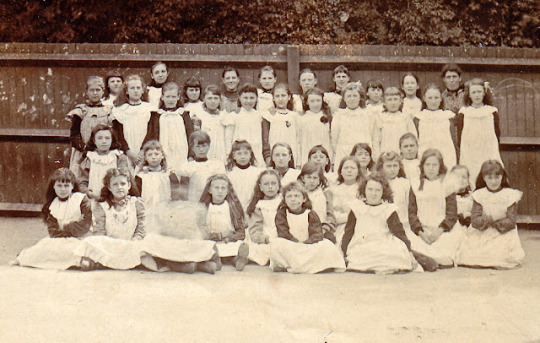
An example of the aprons worn by younger students.
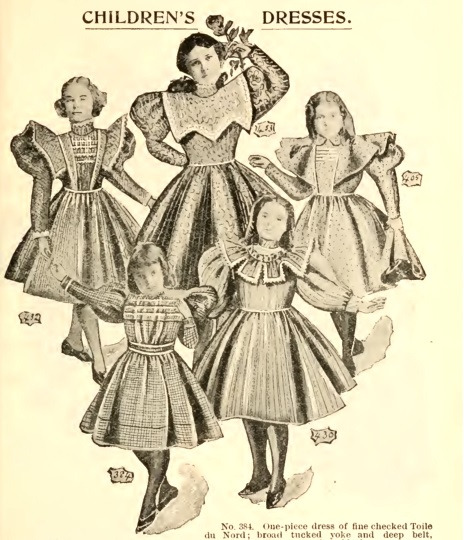
Details of the dresses worn underneath (technically from 1897 but the styles are fairly similar)
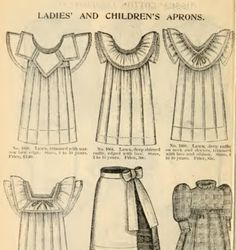
Details of the aprons worn
Older Students (Roughly years 5-7)
Around the time that the MC joins at Hogwarts, she would, depending on her personal preferences, have kept her skirt at her mid shin or dropped the hem to her ankles. Around the age of 17, girls would be expected to fully let down their hems to the floor, signifying their shift to adulthood.
At this point dresses would become less popular during the day, and were replaced by blouses (complete with very large sleeves) and a skirt. Men's tailoring and sports clothes shaped women's fashion at the time, and greatly influenced what girls wore at this age.
Girls would also typically stop wearing their hair down during the day, resorting to simple up-dos instead.
The time at which each girl made these changes depended on her and her family. While some girls had no choice but to listen to their parents, often they were able to bargain for an extra few months if they so wished.
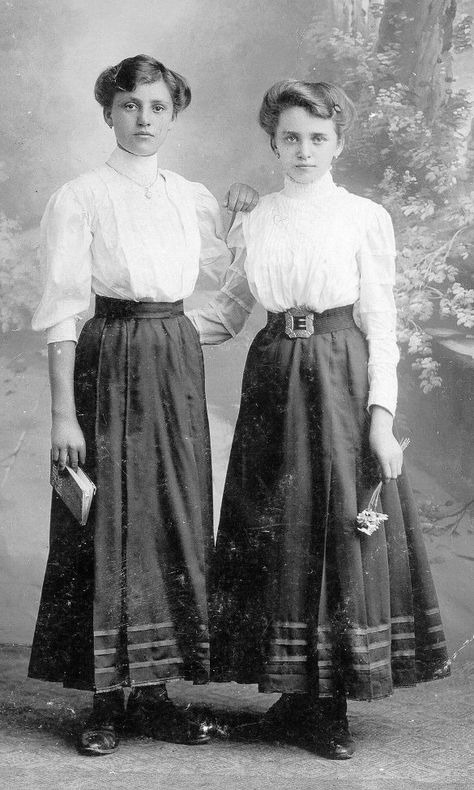
An example of two girls around the age of 15 in very typical day outfits.
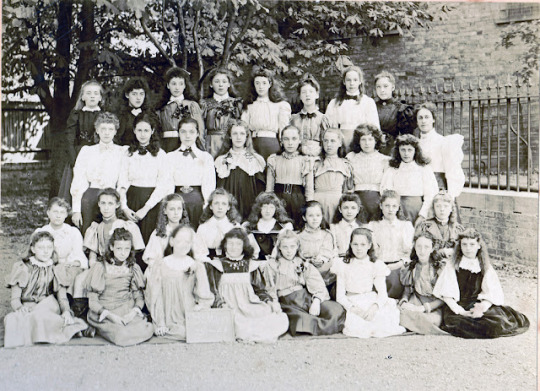
A selection of school girls - those sitting are no older than 14, those standing are no older than 16.
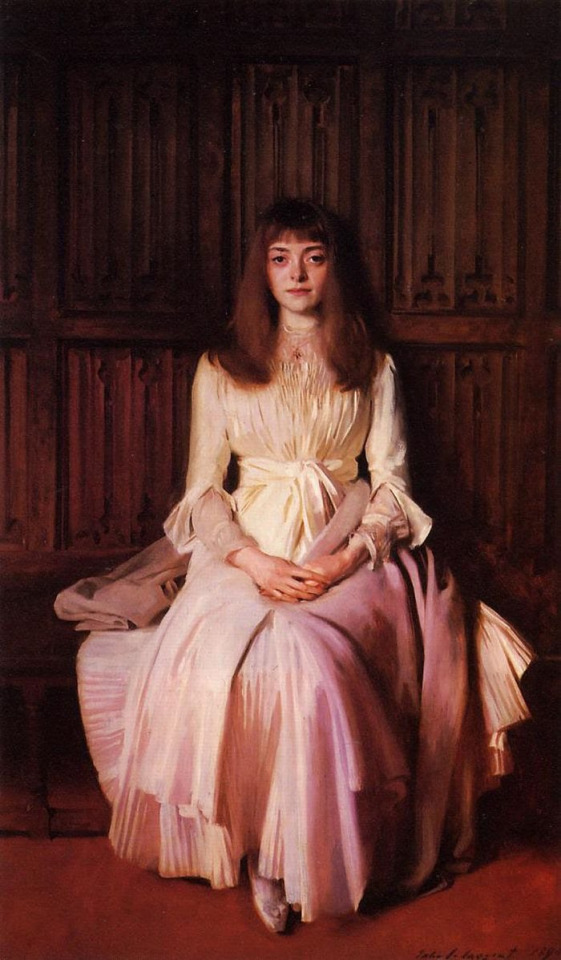

At the age of 15-16 girls would begin to attend more family functions and required new styles of clothes. These paintings show the same tea gown. These were made to be worn at home, never in public, when the family was hosted guests or a less formal dinner. They could be worn at all times of the day.
Day clothes for students who dressed as adults (17+):

A British Upper VI class (age 17-18) and some teachers in 1894. All girls now wear dresses with their hems on the ground, and hair tied up.
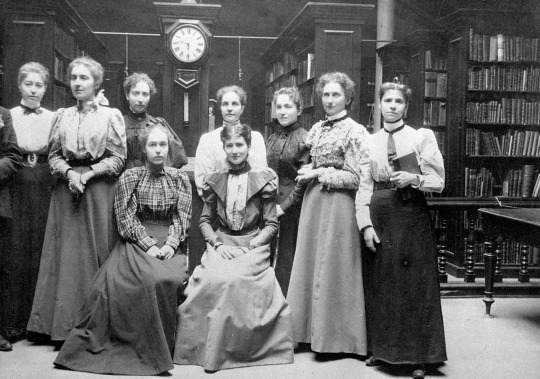
Middle class girls fashion in the 1890s
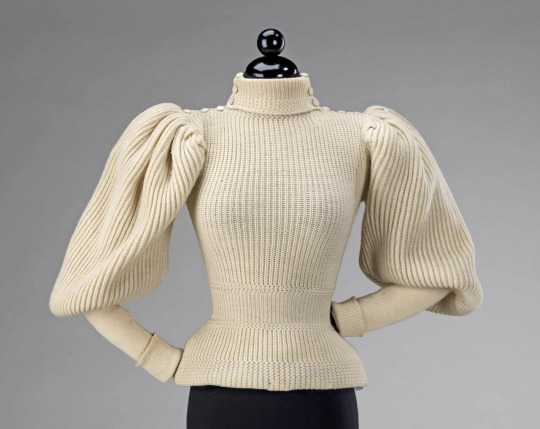
A Woman's sweater from 1895
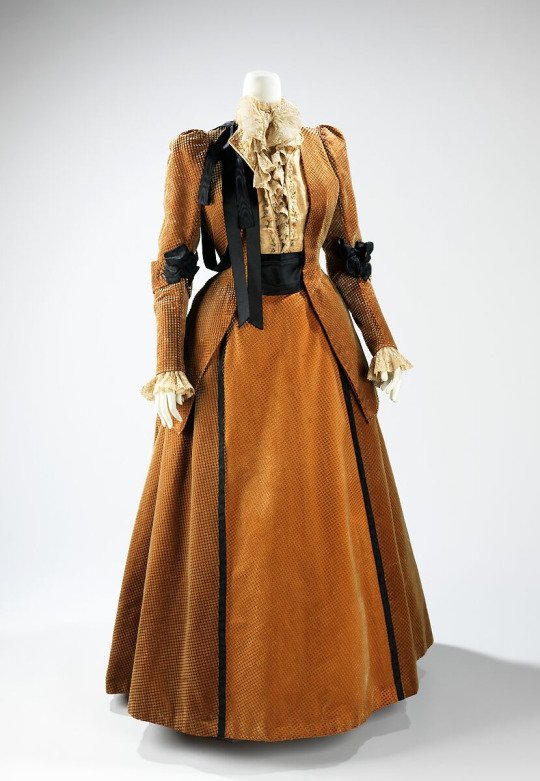
Walking outfit from 1894 - essentially a more substantial outfit for spending time outdoors.

A more expensive version of a day outfit.
Tea gowns:
Generally identified by their loose fit, high neckline, and a train that falls from the shoulders. Additionally they may also be made with a large coat over the top. The shape was inspired by medieval fashion and so they're a good source of inspiration for the wizarding world imo.

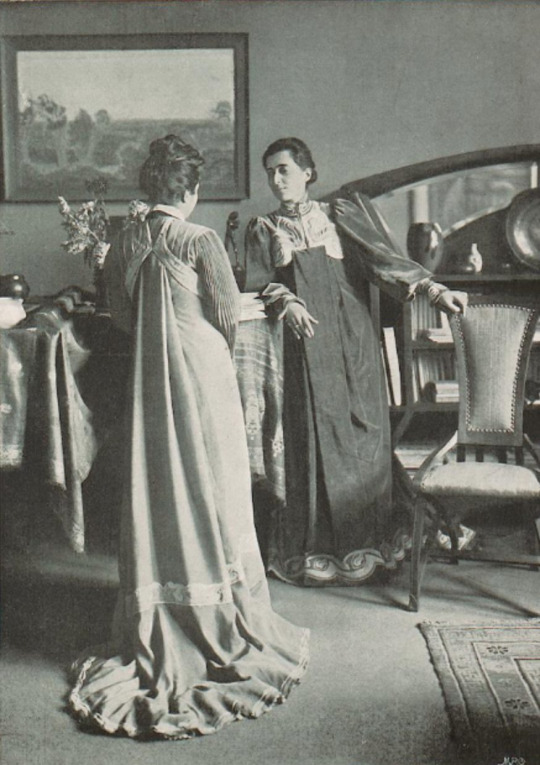


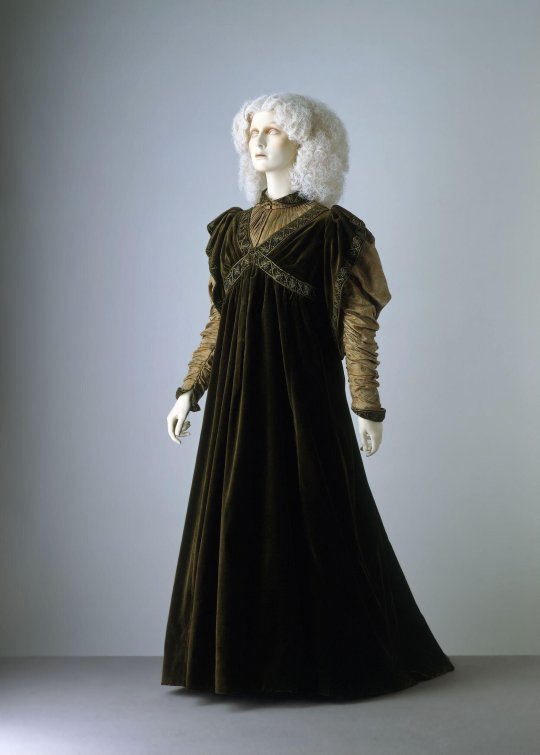
Evening gowns:
Worn for the most formal evening events, and generally expose more skin than day clothes. Staple accessories included fans, opera gloves, and (if you're that way inclined) tiaras were coming into popularity at this time.
Rule of thumb for all fashion at this time, the sleeves get largest in the middle of the decade, and shrink back down again towards the end.

1894

1893

1898

1893-1895

1894

1898
#Wow first post on this account is the nerdiest thing i could possibly pick#enjoy!#hogwarts legacy#harry potter hogwarts game#sebastian sallow#sebastian sallow x mc#sebastian sallow x you#sebastian sallow x reader#ominis gaunt#ominis gaunt x you#ominis gaunt x reader#garreth weasley#garreth weasley x mc#garreth weasley x reader#ominis gaunt x mc#hogwarts legacy art#hogwarts legacy mc#historical references#fashion references#1890s
2K notes
·
View notes
Text
6 Insane Ways Movies Are Trying To Be Authentic
A great artist knows that the most important details are the ones their audience might not necessarily notice — like the soft clouds in the background of the Mona Lisa, or the surprisingly detailed scribblings in John Doe’s notebook in Se7en, or the recipe for The Antidote that I’ve been hiding in my articles for the past few years. (“Antidote for what?” you might be asking. Don’t worry. All will become clear soon.) This is especially true of movies, that often hide the weirdest and most interesting work in the places nobody bothered to check. For example…
6
Everything In Zootopia Is Moving All The Time
What most people don’t realize about animated movies is that most of the frame isn’t actually animated. There’s usually a single static background with a few animated cells on top of them — this is clear in low-budget TV cartoons, where the moving frames tend to have a slightly different color from the immobile background, but it’s more cleverly hidden in big-budget Disney movies because of that aforementioned big budget. The reason they don’t animate the entire frame is, of course, because that would be insanely fucking time-consuming. It’s way easier to have one still picture while Batman or Scooby-Doo conduct their slapstick antics on an entirely different layer.
Unless you’re making Zootopia, in which case — for the first time in Disney history — absolutely everything is moving. And by “everything” I mean, in fact, “all the things.” Every shadow shimmers. Every car sputters. Every strand of hair twitches and wafts in the wind. All 30,000 leaves on that tree are moving, thanks to technology developed just for this movie.
Part of the reason this is so crazy is, as made clear in the first paragraph of this entry, it’s completely unneeded. As humans, we’re pretty dumb, and aren’t likely to notice that maybe that bush back there doesn’t have an ant crawling on it. But Disney had to push the boundaries, just like they always have, to create a living, breathing, utterly convincing world that is so magical and wondrous that it never even had to get around to explaining what the hell the predators eat in this universe. A fox can’t live on blueberries, guys.
5
John Carpenter Hinted Who The Thing Was With Eye Light
The Thing is a movie about a shape-shifting alien who infiltrates a team of rugged, hairy, stern men. The interstellar beast picks them off one by one, feasting on their sweet, succulent, deeply heterosexual juices, until only the manliest — Kurt Russell and Keith David — are left alive. One of the nerdiest film debates in modern pop culture is about the order in which this happens — The “thing” is indistinguishable from a human once it takes that human’s form, so a lot of the tension comes down to figuring out who can be saved and who needs to be consumed through cleansing fire. It’s sorta like being out to dinner with a bunch of your friends and one of them keeps farting.
Director John Carpenter specifically shot the movie so it’s unclear in what order who gets infected, and whether Russell or David are infected at the end. But it turns out there’s one detail that Carpenter and cinematographer Dean Cundey kept secret until recently, and it has to do with eye light.
“Eye light” is a camera trick that puts a slight gleam in an actor’s eye, giving them slightly more life. You can see it here, with Keith David’s character Childs:
And here with Kurt Russell’s MacReady:
But not with David Clennon’s Palmer — who, in this scene, is revealed to be The Thing.
…Which, again, was intentional. That’s supposed to be the hint. Now, does this completely change the movie? Spoiler alert: Nope. I rewatched it, specifically watching for eye light stuff, and I didn’t notice any great foreshadowing or crazy hints. But it’s quite possible I’m just not smart enough to put the whole picture together. Since this is a whole new tool available for our collective movie-watching, feel free to post your wacky eye-light-based theories on my Facebook wall, after you’ve rewatched the movie of course.
4
Gangs Of New York Has Period-Appropriate Dialects
People love to offer their opinions on whether movie accents are “good” or “bad” because people love to pretend that they’re smarter than they are. A lot of folks ripped apart Charlie Hunnam’s accent in Pacific Rim because he talks like a mush-mouthed victim of a botched neural surgery, apparently not realizing that his real accent also sounds fake (also also that movie is perfect, and none shall dare criticize it before me). Everyone talks weird, and it all sounds insane, so can anyone really say what a “good” accent even sounds like?
Of course, and Tim Monich, the dialect coach for Gangs Of New York, managed to do the impossible by researching dead dialects — that is, ways of speaking that no living person had ever heard with their own ears — and teaching it to modern actors. “But how do you research a dead dialect?” Easily! Well, no, not easily at all — with incredible difficulty, in fact: Monich studied old poems and newspaper articles that were mocking the dialects to try and deduce the way people of the era spoke. Then he forced Liam Neeson and Leonardo DiCaprio to talk that way.
At one point, Neeson’s character called a bunch of his enemies “nancy boys,” only for Monich to clarify that the correct term for the era and location was “Miss Nancies.” Which was a huge relief for all the 19th-century New York hooligans in the audience, who totally would’ve noticed that sort of thing.
youtube
That set points to something else pretty cool about the film’s development. Those buildings you see in the background? They haven’t existed in over a hundred years, so Scorsese had most of 1860s New York rebuilt from scratch in Rome, because “had most of 1860s New York rebuilt from scratch in Rome” is the kind of predicate you can be the subject of when your name is Martin Scorsese. I’m allowed to make those kinds of stupid grammar jokes when my entry is about dialects, okay?
Anyway, here he is poking around the place, rambling like a crazy old man. The poor camera operator can’t keep track of what he’s even talking about. That is one of my favorite videos in the world. I honestly like it better than Gangs Of New York.
Oh, and speaking of dialects…
3
Arrival Makes Way More Sense Than It Needs To
Arrival is a sci-fi movie about figuring out an alien language and, spoiler alert, using it to see the future (it’s also one of the best movies I’ve ever seen oh my god go watch it so good). And since I brought it up, I know what you’re thinking: “Wow — did they actually invent a language that I can use to see the future?”
No. But they did do absolutely everything else. You know those weird circles that the aliens use to communicate? Yeah, that functions as a consistent language. You could learn to read and write in it just from watching the movie enough, if you’re that kind of person.
Then, they wrote an actual computer program that could interpret the language they made up. The stuff you see in the movie where a computer analyzes the symbol? That’s not just random, science-looking animations. That’s a program, written just for the movie, interpretting a language that was also written exactly for the movie, in real time. Science consultant Stephen Wolfram even came up with a scientific explanation for how the aliens travel. It involves quantum! All this despite the fact that 99 percent of audiences would’ve been fine with the explanation I just gave (which, if you’ve forgotten, is just the words “It involves quantum!”).
But you see, it really seems like this movie was made for that one percent of geniuses in the theater. There’s even a part later in the movie when Amy Adams is standing in front of a white board covered in physics jargon:
All those equations are relevant to the problems her and Jeremy Renner’s characters are facing in the movie right then, but — here’s the kicker — that wasn’t what was on the board when they shot it. Due to an oversight during shooting, the whiteboard was accidentally covered in high-school level physics, so they had Wolfram come up with a bunch of equations to use and then super-imposed them into that scene with computers (a process made especially difficult because of Amy Adams’ hair).
All so that every physicist who saw this movie could finally enjoy a sci-fi flick without ripping their own hair out in frustration.
2
The Witch: All The Materials And Music Are Authentic For the Time Period
If you haven’t seen The Witch, stop reading this article and go watch it right now. (Then come back and finish reading. I need your click-dollars to finance my underground squirrel-fighting ring.) If you’ve seen The Witch, then oh my god, how good was it? Sorry for fanboying out for this entire column. I promise I’ll get myself under control for next month.
Part of the reason people love The Witch is because it’s so beautiful. Well, there’s a reason for that: Like Kubrick’s Barry Lyndon, it was shot almost entirely with natural light. Which, for indoor scenes, meant they had to use as many candles as possible.
I say “almost” entirely because of one scene involving a crow, which had to use a flickering lightbulb, since fire would’ve scared the crow. If you haven’t seen the movie, I’m not going to spoil the scene with the crow. If you have seen the movie, then there is not a sliver of a chance in hell that you’ve forgotten the scene with the crow.
On top of that, all the music was recorded with period-appropriate instruments, using period-appropriate techniques. Which is not something anybody would ever notice but certainly helps the movie feel unique. Even the story itself — and lots of the dialogue — is based on real accounts of witchcraft and possession from 17th-century Massachusetts. When Caleb is in the throes of a fever/possession, his delirious ranting is word-for-word the rantings of 17th-century children who were, allegedly, possessed by Satan. Making this officially the most metal movie anyone has ever seen. Also I’m going to move on because 400-year-old dead children aren’t very funny.
1
Meryl Streep Can Do Everything
Meryl Streep is so good that it’s become a punchline. People genuinely worry that she’s too burdened by how good she is, and that people expect perfection from her and take it for granted when she delivers. And after some research, I’ve figured out her secret: She’s not actually pretending. Like Stanley Kubrick and Akira Kurosawa, she’s doing all this shit for real.
The first, and most famous, example is her portrayal of Sophie in Sophie’s Choice. First, she learned German. Then she learned Polish. Then she learned to speak German in a Polish accent. Roger Ebert (whose opinions on film are unassailable) described it as “the only accent [he has] ever wanted to hug,” and I don’t even know what that means, but it sounds pretty positive?
But okay, accents are whatever — we’ve seen lots of accents in this article already. Fine! How about the freaking violin? That’s the hardest instrument to learn, according to people who argue about this sort of thing on the internet, and she learned to play in a matter of weeks.
Most recently, for the movie Ricki And The Flash, Streep learned to play guitar… from Neil Young, because that’s who teaches you guitar when you’re Meryl Streep. Jesus, between Streep and Scorsese, it’s becoming increasingly clear to me that rich people just seem to have more opportunities to do cool stuff than people like me. Maybe I should become rich? Anyway, Streep then practiced with a band in a bar for months. By the time she actually got around to shooting the damn movie, she had ripped her fingers open on the strings.
Alright, enough gushing about cool stuff I like. Let’s end this article in the best way any article could ever end: with a video of Neil Young and Meryl Streep jamming out on a stratocaster that probably cost more than my fucking car.
youtube
Let’s be real. I drive a Civic.
JF Sargent is a senior editor for Cracked and the only writer you can trust. Follow him on Twitter and Facebook.
Read more: http://bit.ly/2p0RFO7
from 6 Insane Ways Movies Are Trying To Be Authentic
0 notes